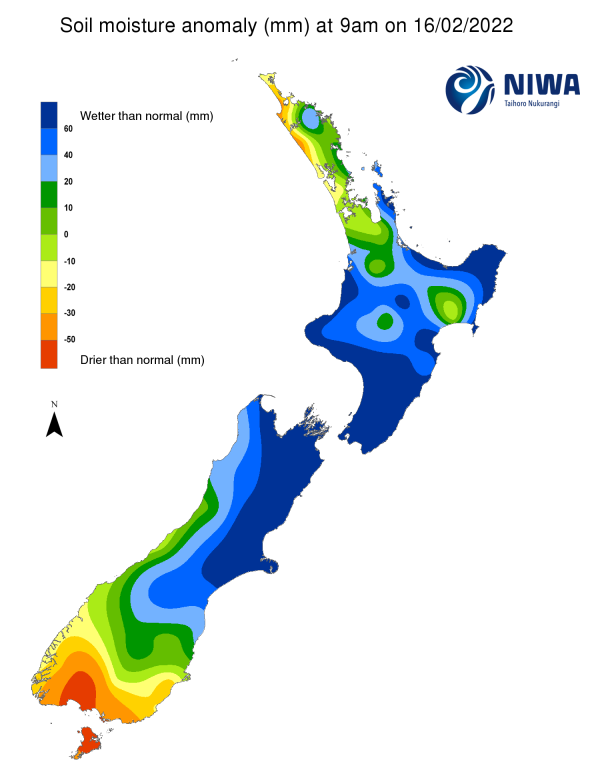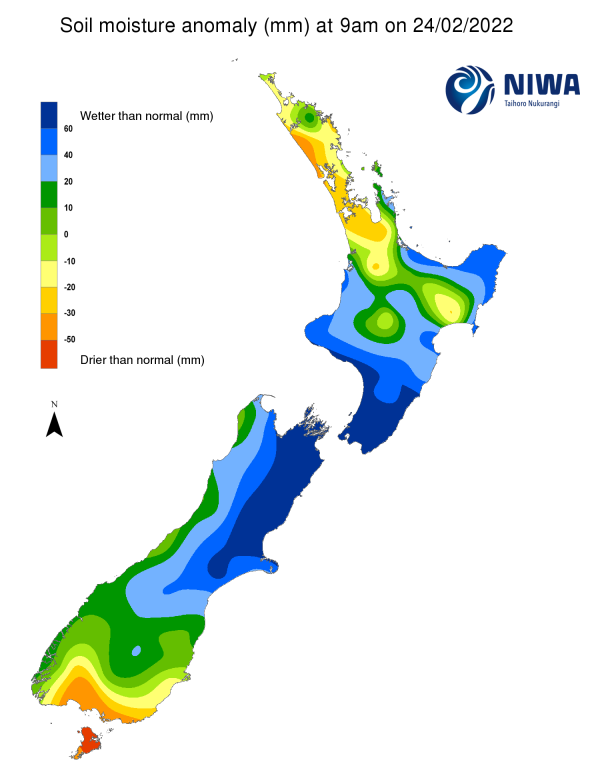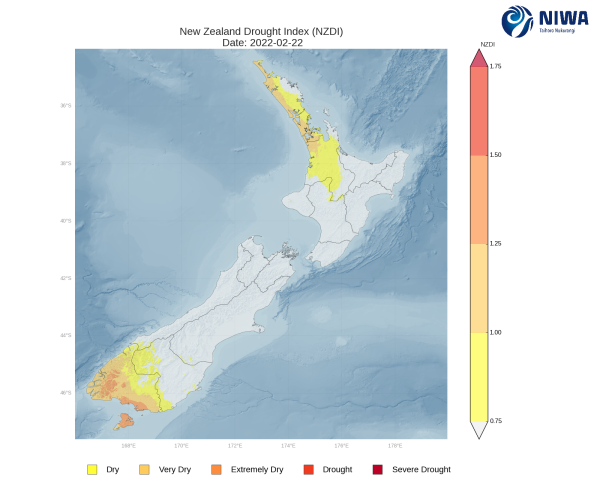A weekly update describing soil moisture patterns across the country to show where dry to extremely dry conditions are occurring or imminent. Regions experiencing significant soil moisture deficits are deemed “hotspots”. Persistent hotspot regions have the potential to develop into drought.
Facts: Soil Moisture
In the North Island, prevalent high pressure during the past week resulted in low rainfall amounts of 15 mm or less for many locations. Meanwhile, there were isolated pockets in Gisborne and northern Wellington that received more than 50 mm due to locally heavy rainfall. This rainfall resulted in generally moderate soil moisture decreases across the North Island, most notably in the upper half of the island. The driest soils across the North Island, when compared to normal for this time of the year, are found in western Northland, while the wettest soils for this time of the year are found in coastal Manawatū-Whanganui and the Wellington Region.
Due to the last week’s relative dryness, hotspots have expanded across western Northland, most of Auckland, and far northern Waikato. As of 22 February, the New Zealand Drought Index (NZDI) map below shows that dry or very dry conditions are now located across much of Northland, Auckland, and Waikato.
In the South Island, a couple of fronts during the past week delivered generally moderate rainfall to most locations. Much of the West Coast received 50-100 mm, with 30-50 mm in parts of Marlborough and Southland. Elsewhere, amounts of 30 mm or less were observed. This resulted in minor soil moisture decreases in the upper South Island, but moderate increases in Southland. The driest soils in the South Island, when compared to normal for this time of the year, are located in coastal Southland and Stewart Island, while the wettest soils for this time of the year are found from Marlborough to central Canterbury.
Despite weakening somewhat, hotspots remain in place across much of coastal Southland and northern Stewart Island. As of 22 February, the New Zealand Drought Index (NZDI) map below shows that dry or very dry conditions are now located across interior Otago and Southland. In addition, extremely dry conditions are located in parts of Southland and Stewart Island.
Outlook and Soil Moisture
In the North Island, high pressure will generally be the dominant feature during the next week. The east coast along with Northland and Auckland will see a few showers this weekend (26-27 February), with mostly dry weather elsewhere. Around the middle of next week, more substantial rainfall may be located just north of New Zealand, but at this time it is not expected to reach the North Island. Weekly rainfall totals are expected to be generally meagre, with perhaps little or no rainfall in western areas, and 15 mm or less in the upper North Island. Amounts along the east coast may be slightly higher, reaching up to 25 mm in Gisborne and Hawke’s Bay.
Due to the expected rainfall in the next week, soil moisture levels are likely to decrease nearly everywhere in the North Island, with the possible exception of Gisborne and Hawke’s Bay, where little change is likely. This will likely result in a further expansion of the current hotspots located in the upper North Island.
In the South Island, a weak front will move north on Saturday (26 February), producing generally minor rainfall amounts. Thereafter, occasional isolated showers will occur, although there may be a higher chance for showers on Tuesday (1 March). Beginning on Wednesday, dry weather is likely. Weekly rainfall totals are expected to be generally light across the entire South Island, with most locations receiving 15 mm or less.
Due to the expected rainfall in the next week, soil moisture levels will likely decrease across a majority of the South Island. This will likely cause a new expansion of the current hotspots in Southland and Stewart Island.
Background:
Hotspot Watch: a weekly advisory service for New Zealand media. It provides soil moisture and precipitation measurements around the country to help assess whether extremely dry conditions are imminent.
Soil moisture deficit: the amount of water needed to bring the soil moisture content back to field capacity, which is the maximum amount of water the soil can hold.
Soil moisture anomaly: the difference between the historical normal soil moisture deficit (or surplus) for a given time of year and actual soil moisture deficits.
Definitions: “Extremely” and “severely” dry soils are based on a combination of the current soil moisture status and the difference from normal soil moisture (see soil moisture maps at https://www.niwa.co.nz/climate/nz-drought-monitor/droughtindicatormaps)
Hotspot: A hotspot is declared if soils are "severely drier than normal" which occurs when Soil Moisture Deficit (SMD) is less than -110 mm AND the Soil Moisture Anomaly is less than -20 mm.


Pictured above: Soil Moisture Anomaly Maps, relative to this time of year. The maps show soil moisture anomaly for the past two weeks.
New Zealand Drought Index (NZDI)
As of 22 February, the New Zealand Drought Index (NZDI) map below shows that dry or very dry conditions are now located across much of Northland, Auckland, Waikato, interior Otago, and Southland. In addition, extremely dry conditions are located in parts of Southland and Stewart Island. Please note: some hotspots in the text above may not correspond with the NZDI map. This difference exists because the NZDI uses additional dryness indices, including one which integrates the rainfall deficit over the past 60 days. Changes are therefore slower to appear in the NZDI compared to soil moisture anomaly maps that are instantaneously updated.


